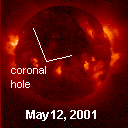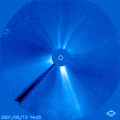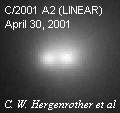|   SPACE WEATHER SPACE WEATHER
Current
Conditions
Solar Wind
velocity: 483.0 km/s
density:3.5 protons/cm3
explanation | more data
Updated: Today at 2245 UT
X-ray Solar Flares
6-hr max: B9 2150 UT May14
24-hr: C3 0325 UT May14
explanation | more data
Updated: Today at 2245 UT
Daily Sun: 14 May '01 
Active regions 9454 and 9455 have beta-gamma magnetic fields that harbor energy for M-class solar flares. AR 9455 unleashed two M3-class flares during the weekend. Image credit: SOHO/MDI
The Far Side of the Sun
This holographic image reveals no substandtial spots on the far side of the Sun. Giant spot AR9393, which appeared in May 9th farside data, is located in a low-sensitivity region of this image. Image credit: SOHO/MDI
Sunspot Number: 119
More about sunspots
Updated: 13 May 2001
Radio Meteor Rate
24 hr max: 54 per hr
Listen to the Meteor Radar!
Updated: 13 May 2001 Interplanetary Mag. Field
Btotal: 5.4 nT
Bz: 2.2 nT north
explanation | more data
Updated: Today at 2246 UT Coronal Holes:

A large coronal hole that crossed the Sun's central meridian last Friday and Saturday sent a high-speed solar wind stream toward Earth. Image credit: Yohkoh Soft X-ray Telescope.
More about coronal holes
 SPACE WEATHER SPACE WEATHER
NOAA
Forecasts
Solar Flares: Probabilities for a medium-sized (M-class) or a major (X-class) solar flare during the next 24/48 hours are tabulated below.
Updated at 2001 May 14 2200 UT
| FLARE | 24 hr | 48 hr | | CLASS M | 30 % | 30 % | | CLASS X | 05 % | 05 % |
Geomagnetic Storms: Probabilities for significant disturbances in Earth's magnetic field are given for three activity levels: active, minor storm, severe storm
Updated at 2001 May 14 2200 UT Mid-latitudes | 24 hr | 48 hr | | ACTIVE | 25 % | 20 % | | MINOR | 05 % | 05 % | | SEVERE | 01 % | 01 % |
High latitudes | 24 hr | 48 hr | | ACTIVE | 30 % | 30 % | | MINOR | 10 % | 10 % | | SEVERE | 05 % | 01 % |

Web server provided by
VPS Hosting
| What's Up in Space -- 14 May 2001
Subscribe to Space Weather News!  THE PLEIADES AND A CME: Yesterday the Solar and Heliospheric Observatory spotted this double-lobed coronal mass ejection (CME) billowing away from the Sun. The little dipper-shaped grouping of seven stars at the upper left are the Pleiades. The so-called "Seven Sisters" are now only 6o from the Sun and, thus, impossible to see with the unaided eye. However, the occulting disk of SOHO's coronagraph blocks the Sun's blinding glare to reveal the faint corona as well as surrounding stars and planets. [350 kb movie] THE PLEIADES AND A CME: Yesterday the Solar and Heliospheric Observatory spotted this double-lobed coronal mass ejection (CME) billowing away from the Sun. The little dipper-shaped grouping of seven stars at the upper left are the Pleiades. The so-called "Seven Sisters" are now only 6o from the Sun and, thus, impossible to see with the unaided eye. However, the occulting disk of SOHO's coronagraph blocks the Sun's blinding glare to reveal the faint corona as well as surrounding stars and planets. [350 kb movie]
GEOMAGNETIC STORM: This weekend Earth entered a high-speed solar wind stream flowing from a large coronal hole on the Sun. Solar wind gusts triggered a G2-class geomagnetic storm on May 12th and lesser disturbances on May 13th. Today our planet is exiting the stream and storm conditions have mostly subsided. 
Above: The planetary K-index, a measure of global geomagnetic unrest, registered storm conditions (red) on May 12th and 13th. THE SUNSPOT THAT WOULDN'T DIE: Recent SOHO/MDI holographic images of the far side of the Sun reveal an old friend: long-lived active region 9393. Once the largest sunspot of the current solar cycle (and the source of the most powerful solar flare ever recorded) AR9393 has already crossed the face of our star twice. If it survives for a few more days, we'll see it again emerging over the Sun's east limb for an unusual third transit. 
Above: A holographic image of the Sun on May 9th created by SOHO's Michelson Doppler Imager team.  BRIGHTENING COMET: Comet C/2001 A2 (LINEAR), which split into two pieces last month, suddenly brightened to visual magnitude ~5.3 on May 10th and 11th. The comet's appearance is changing as volatile ices in the fragmenting nucleus are exposed to solar radiation. No one knows how much brighter Comet LINEAR A2 might become between now and May 24th, when it will experience a 0.78 AU close encounter with the Sun. Southern hemisphere sky watchers using binoculars can monitor the crumbling comet after local sunset near the feet of Orion. See: [3D orbit][ephemeris][May 13th finder chart] BRIGHTENING COMET: Comet C/2001 A2 (LINEAR), which split into two pieces last month, suddenly brightened to visual magnitude ~5.3 on May 10th and 11th. The comet's appearance is changing as volatile ices in the fragmenting nucleus are exposed to solar radiation. No one knows how much brighter Comet LINEAR A2 might become between now and May 24th, when it will experience a 0.78 AU close encounter with the Sun. Southern hemisphere sky watchers using binoculars can monitor the crumbling comet after local sunset near the feet of Orion. See: [3D orbit][ephemeris][May 13th finder chart]
WEB LINKS: NOAA FORECAST | GLOSSARY | SPACE WEATHER TUTORIAL | LESSON PLANS | BECOME A SUBSCRIBER | 
Potentially Hazardous Asteroids (PHAs) are space rocks larger than approximately 100m that can come closer to Earth than 0.05 AU. None of the known PHAs are on a collision course with our planet, although astronomers are finding new ones all the time. [more]
On 14 May 2001 there were 307 known Potentially
Hazardous Asteroids May 2001 Earth-asteroid encounters | ASTEROID | DATE (UT) | MISS DISTANCE | | 2001 GQ2 | 2001-Apr-27 12:00 | 7.7 LD | | 2001 FE90 | 2001-May-06 23:37 | 49.7 LD | | 1999 KW4 | 2001-May-25 23:31 | 12.6 LD | Note: LD is a "Lunar Distance." 1 LD = 384,401 km, the distance between Earth and the Moon 
- TOTAL LUNAR ECLIPSE: On Jan. 9, 2001, the full Moon glided through Earth's copper-colored shadow. [gallery]
- CHRISTMAS ECLIPSE: Sky watchers across North America enjoyed a partial solar eclipse on Christmas Day 2000 [gallery]
- LEONIDS 2000: Observers around the globe enjoyed three predicted episodes of shooting stars. [gallery]
 Feb. 21, 2001: Nature's Tiniest Space Junk -- Using an experimental radar at the Marshall Space Flight Center, scientists are monitoring tiny but hazardous meteoroids that swarm around our planet. Feb. 15, 2001: The Sun Does a Flip -- NASA scientists who monitor the Sun say our star's enormous magnetic field is reversing -- a sure sign that solar maximum is here. Jan. 25, 2001: Earth's Invisible Magnetic Tail -- NASA's IMAGE spacecraft, the first to enjoy a global view of the magnetosphere, spotted a curious plasma tail pointing from Earth toward the Sun. Jan. 4, 2001: Earth at Perihelion -- On January 4, 2001, our planet made its annual closest approach to the Sun. Dec. 29, 2000: Millennium Meteors -- North Americans will have a front-row seat for a brief but powerful meteor shower on January 3, 2001. Dec. 28, 2000: Galileo Looks for Auroras on Ganymede -- NASA's durable Galileo spacecraft flew above the solar system's largest moon this morning in search of extraterrestrial "Northern Lights" Dec. 22, 2000: Watching the Angry Sun -- Solar physicists are enjoying their best-ever look at a Solar Maximum thanks to NOAA and NASA satellites. MORE SPACE WEATHER HEADLINES |

